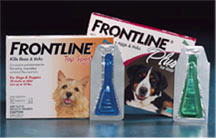How to protect your dog against ticks and fleas
Although it is impossible to completely keep ticks and fleas at bay, there are some steps you can take to help minimise their contact with your pet.
Fleas
There are a few things you can do to reduce the chances of your pet getting fleas:
- Frontline – You can use this treatment from Frontline to prevent and treat your pets against fleas. They recommend treating cats every 5 weeks and dogs every two months.
- Vacuum – One of the most overlooked areas is just vacuuming your house on a regular basis. This will reduce the number of flea eggs and larvae that are present.
- Flea shampoo – You can use flea shampoo as both a preventative measure and a cure. Bathing your pets with flea shampoo can significantly reduce the chances of infection and can go a long way to curing them of it. However, make sure you don’t do this too much as it can dry out your pets skin.
- Wash your pets bedding – It’s important to ensure all bedding, blankets or collars that your pet wears are regularly cleaned.
- Consult your veterinarian – When it comes to any treatment for your pets, always consult your vet. This will help you to understand what fleas are, what treatments are suitable for your pets and what to do in the event that your pet gets fleas.
Ticks
Dogs are very susceptible to tick bites and tick-borne diseases. Tick bites on dogs may be hard to detect. Signs of tick-borne disease may not appear for 7-21 days or longer after a tick bite, so watch your dog closely for changes in behavior or appetite if you suspect that your pet has been bitten by a tick.
To reduce the chances that a tick will transmit disease to you or your pets:
- Check your pets for ticks daily, especially after they spend time outdoors.
- If you find a tick on your dog, remove it right away.
- Ask your veterinarian to conduct a tick check at each exam.
- Talk to your veterinarian about tickborne diseases in your area.
- Reduce tick habitat in your yard.
- Talk with your veterinarian about using tick preventives on your pet.
Use a flea and tick control product
 Despite your best efforts to reduce your dog's contact with ticks and fleas, you should still take measures to help protect them. Treat all dogs and cats in the household with a flea and tick control product. One untreated pet can lead to a flea infestation in the household. Flea and tick control products can help protect your dog from unexpected flea and tick sources by killing adult fleas, eggs and larvae, and all stages of ticks.
Despite your best efforts to reduce your dog's contact with ticks and fleas, you should still take measures to help protect them. Treat all dogs and cats in the household with a flea and tick control product. One untreated pet can lead to a flea infestation in the household. Flea and tick control products can help protect your dog from unexpected flea and tick sources by killing adult fleas, eggs and larvae, and all stages of ticks.
Once-a-month topical insecticides are the most commonly used flea prevention products on the market. They are applied to a small area on your pet's back, are probably the easiest product to use, and generally last the longest. Some kill fleas and ticks, and others just kill fleas, so check the label carefully. Ingredients generally include permethrin, fipronil, imidacloprid, pyriproxyfen, spinosad, metaflumizone, and selamectin.
This is the method we use with Baxter, applying the dose to an area of skin at the back of his neck, where he is unlikely to reach it should he feel the need to scratch an itch.
Consistency is key to maintaining adequate protection. Even one missed dose of your dog's monthly flea and tick control can set the stage for a flea infestation that takes months to resolve, or put your pet at greater risk of exposure to a tick borne disease. So it is important that you treat your pet and continue monthly applications throughout the rest of the year or as directed by your vet.

